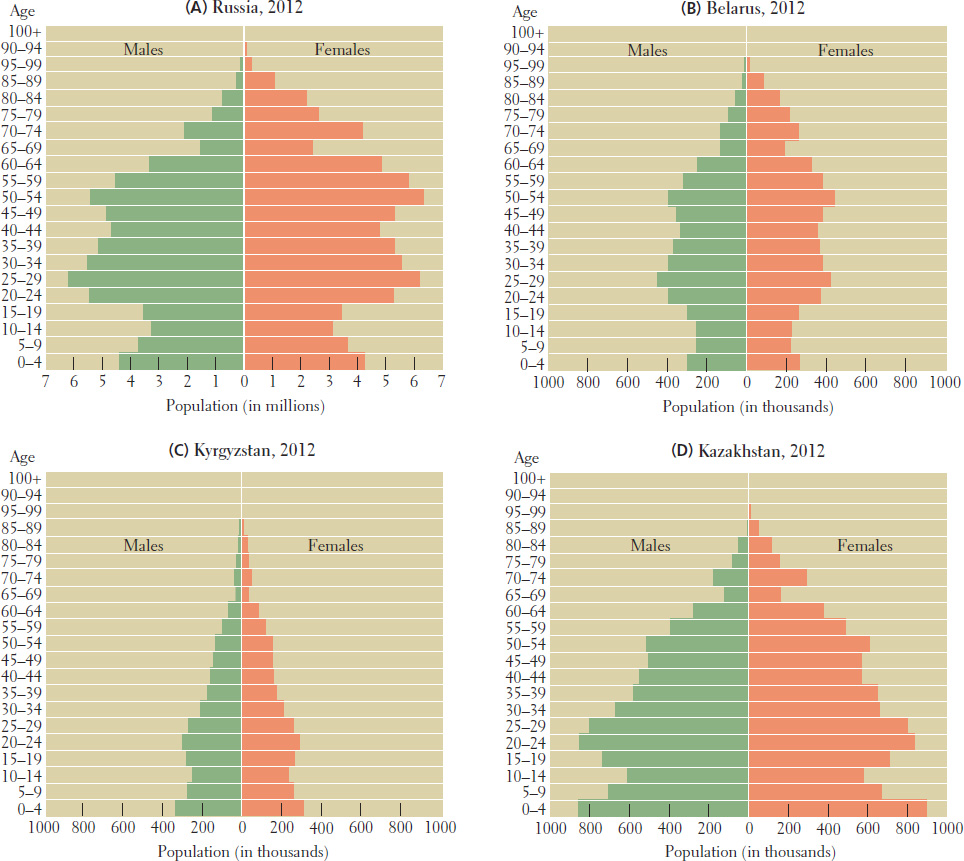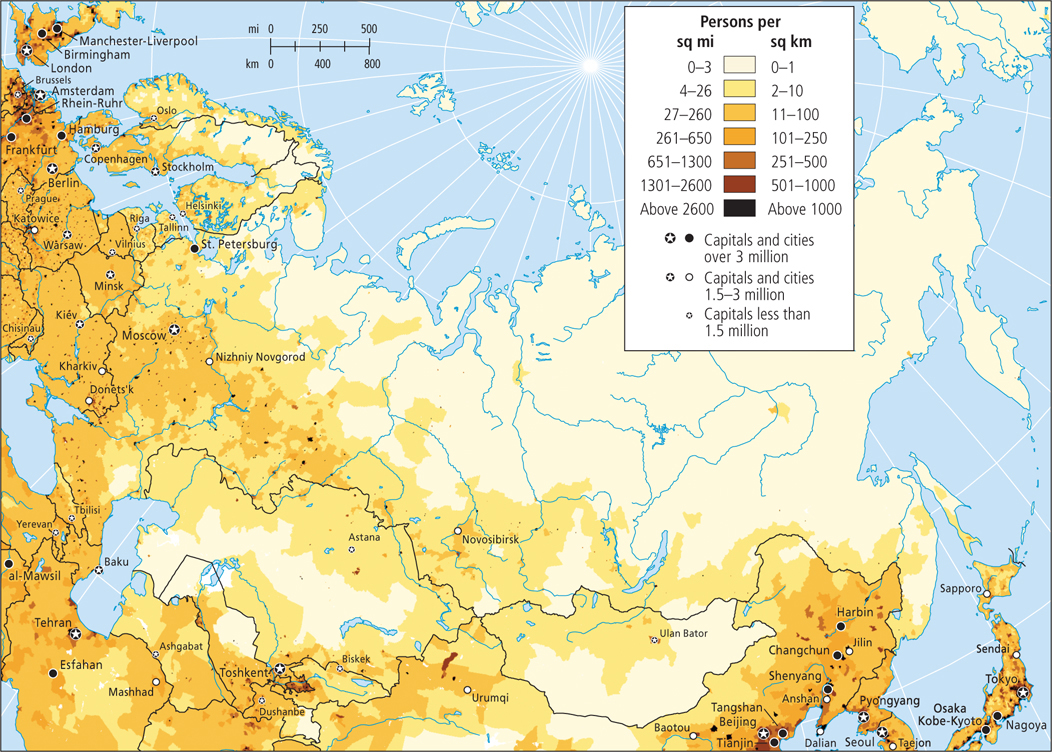5.8 POPULATION AND GENDER
GEOGRAPHIC INSIGHT 5
Population and Gender: Populations are shrinking in many parts of the region due largely to lower birth rates and declines in life expectancy. These changes relate to consistently high levels of participation by women in the workforce and to the economic decline in the 1990s that followed the collapse of the Soviet Union. Men and women have been affected differently in the post-
With high death rates and low birth rates, this region is undergoing a unique, late-
By the mid-
Russia has made considerable efforts to fight population decline. Couples are now offered a bonus for having a second child that is equivalent to more than 2 years’ worth of wages for the average Russian. However, similar policies in Europe have been less successful than efforts to address the concerns of career-
Gender and Life Expectancy
Much of the reason for the population decline, and possibly the recent slowing of this decline, relates to life expectancy. Life expectancy in the region differs dramatically according to gender, with women living 10 to 12 years longer than men. By comparison, around the world, women live on average only 53 years longer than men. Life expectancy for women changed only marginally after the collapse of the Soviet Union, but life expectancy for men dropped considerably. In Russia, for example, between 1987 and 1994, male life expectancy dropped from 64.9 to 57.6 years. Since then, male life expectancy has recovered somewhat, but at 64 years, it is still the shortest in any developed country. Female life expectancy has held steady at 75 to 76 years throughout this period.
Major causes of low life expectancies in the region are the loss of health care, which was usually tied to employment, and the physical and mental distress caused by lost jobs and social disruption. These factors, though, might not explain much of the gender difference in life expectancy since the fall of the Soviet Union, given that women worked outside the home almost as much as men during the Soviet era and seem to have been more likely to have lost jobs during the 1990s. Another possible cause for low male life expectancy is alcohol abuse and alcohol-
Population pyramids for several countries (Figure 5.21) show the overall population trends in the region and reflect geographic differences in life expectancy and fertility. The pyramids for Belarus and Russia resemble those of European countries (for example, Germany, as shown in Figure 4.21A), but there are also differences. First, they are significantly narrower at the bottom, indicating that birth rates in the last several decades have declined sharply. Because so few children are born, in 20 years there will be few prospective parents, which means that low birth rates and population decline will probably continue into the foreseeable future. Also, the narrower point at the top for males shows their much shorter average life span compared to women.

In all countries, there has been a recent rebound in birth rates in the youngest age group, ranging from a slight increase in Russia to a significant rebound in Kazakhstan. Kyrgyzstan’s pyramid indicates a younger population structure, which is common in less affluent economies. In the Central Asian countries, population will likely expand during the next decades.
Population Distribution
A broad area of moderately dense population forms an irregular triangle that stretches from Ukraine on the Black Sea north to St. Petersburg on the Baltic Sea and east to Novosibirsk, the largest city in Siberia. In this triangle, settlement is highly urbanized, but the cities are widely dispersed (Figure 5.22).

A secondary spur of dense settlement extends south from Russia into Caucasia, the mountainous region between the Black Sea and the Caspian Sea, where there are several primate cities of well over 1 million people each. In Central Asia, another patch of relatively dense settlement is centered on the cities of Tashkent. Along major Central Asian rivers during the Soviet period, the development of irrigated cotton farming and mineral extraction resulted in patches of high rural density, fueled partly by ethnic Russian immigration.
Caucasia the mountainous region between the Black Sea and the Caspian Sea
THINGS TO REMEMBER
GEOGRAPHIC INSIGHT 5
Population and Gender Populations are shrinking in many parts of the region due largely to lower birth rates and declines in life expectancy. These changes relate to consistently high levels of participation by women in the workforce and to the economic decline in the 1990s that followed the collapse of the Soviet Union. Men and women have been affected differently in the post-
Soviet era, with men much more likely to suffer from alcoholism and related health problems. By the mid-
2000s, the rate of population decline had slowed down considerably across the region, and by 2013 Russia’s population was again growing. Life expectancy in the region differs dramatically according to gender, with women living 10 to 12 years longer than men. By comparison, around the world, women live on average only 5 years longer than men.
Recent increases in male life expectancy may be a result of declining rates of alcohol poisoning since the mid-
2000s. This change is likely an outcome of government and private campaigns to reduce alcohol consumption and improve treatment of alcoholism.